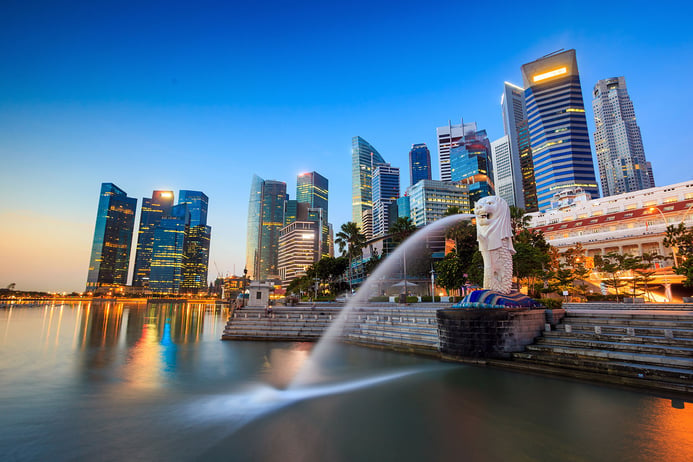Singapore's Culture
Singapore's national language is Malay. There are four official languages in Singapore: Malay, English, Chinese, and Tamil, and you'll probably also hear Singlish - the unique mix of Singapore's official languages and English. 75% of Singaporeans are ethnically Chinese, mostly from the Hokkien or Teochew communities. An estimated 6% of Singaporeans are Tamil, heralding from Southern India, and about 15% are Malay Muslims. That leaves 4% of Singaporeans with mixed or other heritage.
Singapore's flag is red and white with a crescent moon and five stars. The five stars symbolize five ideals - democracy, peace, progress, justice and equality - while the moon symbolizes a rising nation (it was founded in 1965). The white suggests purity while the red denotes the equality of mankind.
Singaporeans are very polite and there's a good reason for that. The government taught manners under the National Courtesy Campaign. While the manners campaign has been running since the 1970s, it got a rebranding in 2001, and is better known now as Singapore Kindness Movement.
Male Singaporeans must serve in the military for 1-2 years.
Singapore ranks among the lowest nations for freedom of the press, coming in at 151 of 180 nations according to the Reporters without Borders survey.
Singapore has a unique national icon: a half lion, half fish creature known as the Merlion. You'll find Merlion statues throughout Singapore, but don't miss the Sentosa Merlion as you can go inside!
Switzerland and Singapore are the 2 top countries in the world for expats due to quality of life. According to some estimates, Singapore has around 1.5 million expats. The country's expat population is split, roughly 50-50, between corporate workers and blue-collar domestic or construction workers. The expats also enjoy the widespread public services, low-key tax framework, near no corruption, and high level of competition (Singapore falls third, coming in right behind Switzerland).
Singapore has its own unique way of honoring Feng shui: the towers in the Suntec City development are shaped into the palm of a hand, which is a beneficial Feng shui symbol. Suntec City is also home to the largest fountain in the world, which is known as the Fountain of Wealth. At the time of its construction, the fountain cost $6 million to build.
Singapore's Economy
The Prime Minister of Singapore out-earns the President of the United States (and many other global leaders) by a multiple of four or five, with an annual salary of $1.7 million. The Swiss Prime Minister earned around $500,000, in contrast.
Singapore is open for business! From 2006 through 2016, the tiny country topped the World Bank's index of easiest countries to do business with. Times have changed and the unlikely New Zealand is now the easiest country to do business with. Singapore ranks as the second most easy nation with which to do business, followed by Denmark.
Who wants to be a millionaire? That's something one in six Singaporeans don't have to worry about, because they already have over $1 million in assets!
Given all this economic data, it might not surprise you to know that Singapore is among the most expensive cities in the world. For 2019, Singapore shares the top spot with Hong Kong and Paris - a dubious honor.
Singapore's national anthem could be in your wallet. It's printed in very tiny text on the back of the $1,000 note.
Singapore's Food
At a hawker center you could enjoy a Michelin starred meal of chicken and rice for as little as $2. Singapore's hawker centers provide some of the best food in the nation, and have drawn interest from celebrity chefs including Gordon Ramsay.
All that yummy food you're eating has to come from somewhere, and only 7% of the food that's eaten in Singapore is grown locally. There are farms in Kranji, in the north of Singapore, as well as on top of the roofs of condos and shopping centers.
The Singapore Sling is an old-fashioned bar favorite. The cocktail, which is made with gin, Cointreau, Dom Benedictine, cherry Brandy, Angostura bitters, pineapple juice, grenadine, and limes, was first served in the famous Raffles Hotel in 1915.
Fancy a hug? Then head to the National University of Singapore where you can grab a coke from a first of its kind "Hug Me" Coca-Cola vending machine.
Some estimates suggest that two restaurants open every day in Singapore - that's how much Singaporeans love to eat. An unfortunate reality is that by their fifth year, 40% of those restaurants have closed!
Singapore's Geography
Singapore's surface is just over 719 km2 which makes the nation the 20th smallest countries that exist.
Ever wonder why both the country and the city are known as Singapore? The island is one of only three city-states. The other two are Vatican City and Monaco.
While its land mass is small, Singapore has over 3,000 kilometers of roads. If you could unwind the roads end to end, they would take you from Singapore all the way to Hong Kong.
Singapore sets a height limit for its buildings, which is 280 meters. You'll find three buildings to date that reach exactly 280 meters in height. The height limit for buildings stems from the fact that the military base is situated close to the downtown business area since Singapore is a small country. For the safety of the military planes, the buildings can't be too tall.
Singapore's skyscrapers are over 100 meters taller than the highest natural point in the country. The highpoint, as it's known, which is Bukit Timah Hill, is only 164 meters high. Along with Bukit Timah Hill, the Bukit Timah Nature Reserve offers an incredible diversity of flora. You'll find more tree species in a hectare of the nature reserve than you will across the entirety of North America.
A joint study from the Massachusetts Institute of Technology and the World Economic Forum credited Singapore as the greenest city: 30% of the city is green, due to Singaporeans' love of gardens and other green spaces. Don't be surprised if you see wildlife such as monitor lizards or snakes in the heart of the city. Perhaps because of all that green space, Singapore is the second most densely populated nation, coming in after Monaco.
Singapore is growing. Since the British arrived in 1822, the island has been reclaiming land from the sea. According to some estimates, as much as 25% of Singapore's present day land mass didn't exist at independence. Why the need for so much land? Growth of industry and population. The Marina Bay Sands Hotel is one of the most famous sights in Singapore, and it's built entirely on reclaimed land.
For Singapore, the land reclamation efforts mean doing battle with the sea, a fate the befalls other low-lying nations such as Tuvalu or Nauru.
Think Singapore is a single island? Think again: there are actually 63 islands, although many are uninhabited.
Singapore's Sports
Singaporeans could win a world record in walking, with an average walking speed of 6.15 km/h.
Singapore’s National Stadium doesn't close for rain delays. The stadium has a giant canopy shelter that's capable of covering 55'000 fans from inclement weather, and a large retractable dome - at 312 meters, the biggest in the world.
Singapore didn't win an Olympic Gold medal until 2016, in Rio, where a 21-year-old swimmer won gold in the 100-meter butterfly.
Singapore's Animals
The first of its kind night zoo is in Singapore. Called the Night Safari, the zoo is open every day from 7:15 p.m. to midnight. When you visit at night, you'll enjoy nocturnal animals including Asian elephant, pangolin, Malaysian tapir, cloud leopard, and fishing cat.
The largest bat in the world, which has a wing span of 1.5 meters, is located on an island off the coast.
Singapore's Entertainment
Every year since 2008, Singapore has hosted a Formula 1 Grand Prix, which has the unique distinction of being the first ever Formula 1 night race. Concerts and other entertainment lead up to the exciting race, where cars wind through the Marina Bay neighborhood.
The whole country goes on sale for the Great Singapore Sale, held annually in June. The event, which is organized by the Singapore Retailers Association, was developed to promote tourism in the region.
Foodies may want to visit in July, when the annual Singapore Food Festival is held. Festival-goers munch on mod-sin or modern Singaporean foods as well as traditional dishes.
Singapore is home to the tallest indoor waterfall, inside the Gardens by the Bay conservatory. In addition to the 35-meter waterfall you'll find local flora from the tropical highlands.
Singapore Botanic Gardens belong to the UNESCO World Heritage list. The gardens are the third botanical gardens and the first-ever tropical garden named to UNESCO's list.
Singapore's World Records
On your way to or from the country, spend some time in the airport. Changi Airport has won the best airport in Asia award for close to 30 years. The country also took home the first place at the World Airport Awards for seven years in a row, and has won the award 10 times in the 20-year history of the World Airport Awards.
A Guinness record for the longest human domino chain was set in 2000, when 9,234 local students stood in a domino formation.
Singapore set a record for the biggest pass-the-parcel game, in which 3,918 students removed wrappers from a package measuring 1.5 meters by 1.5 meters by 0.5 meters. A total of 2,200 wrappers were removed from the package.
Singapore also set a record for line dancing in 2002, when 11,967 people participated in a line dance.
Singapore's busy students formed a chain of coins that spelled out a positive phrase on never giving up to create another inventive world record for the longest coin chain, at 199.8 meters.
The youngest person who ever passed the GCE ‘O’ Level Chemistry test was a 7-year old Singaporean.
Singapore residents have one of the best life expectancies in Asia, with an average anticipated life span of 84.





